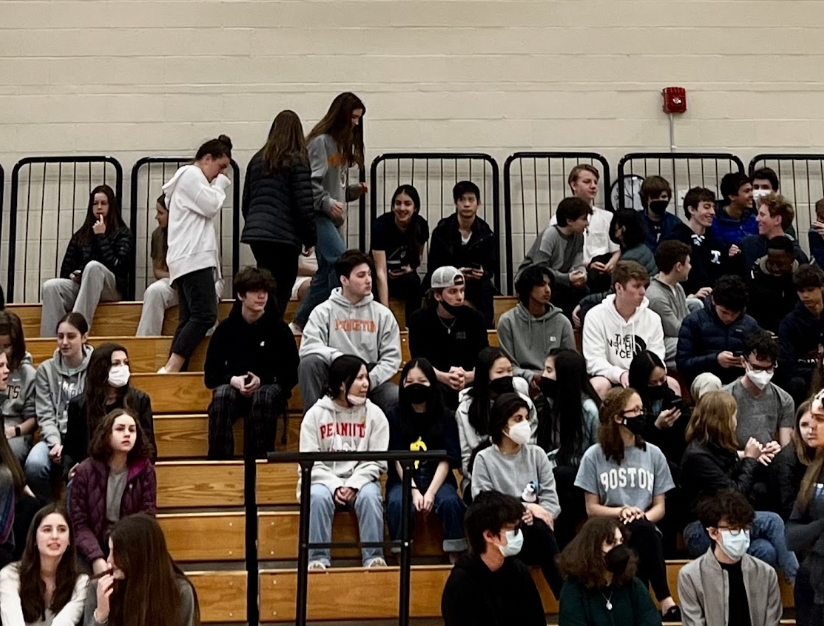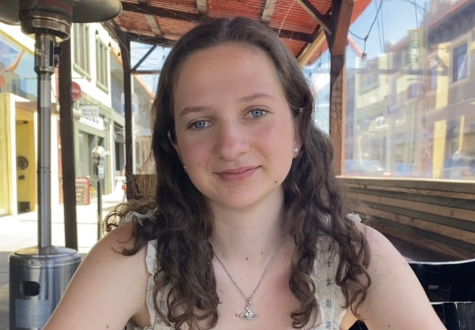To mask or not to mask: Campuses shift to mask optional
May 6, 2022
Since the transition to a mask-optional school in late March, Evie Varghese ’28
has seen the faces of her peers, found it easier to breathe when running during recess, and laughed with her peers when they forgot whether or not they had masks on.
“One of my friends put their mask on and accidentally drank]through the mask,” Evie said. “It was hilarious.”
The new mask policy on campus was instituted on March 29, 2022, when Head of School Dr. Jen Price sent out an email detailing the new COVID plan. In the address, she informed the community of the new protocol—individuals can choose whether or not to wear a mask.
The decision came following consistent tracking of state and local COVID data, collaboration with Dr. Rick Goldstein, the school’s consulting physician at Boston Children’s Hospital, and Director of Student Support Services Kimberly Gold, watching the recommendations from the Cambridge Department of Public Health, and testing following spring break, resulting in what Dr. Price called a “data-informed” journey.
The school continues to offer take-home antigen tests for those who want it in accordance with state offerings. As of April 12, 625 students and 221 faculty members are enrolled in the antigen testing program.
On March 30, students could be seen smiling, laughing, and conversing with each other inside, many maskless. This change comes after two years of mask requirements, along with strict enforcement and even the threat of punishment for incorrect mask wearing (See “Faculty making list, checking it twice” 50.6).
For Dr. Price, the change meant a new opportunity for personal connection and familiarity with younger students. One moment that stood out to her, she said, was seeing kindergarteners’ and first graders’ faces for the first time, as well as giving them the opportunity to see the entirety of her face.
“These students have been at the school for almost two years and I have never seen them and they have never seen me, so having that moment of seeing each other maskless for the first time was just wonderful,” she said. “It was nice to see the kids interacting with the teachers and to see their expressions and smiling faces.”
While the decision to wear a mask is in student and faculty hands now, there is still a possibility that the school could return to requiring masks, Dr. Price noted.
“At this moment, it feels safe, smart and thoughtful to be able to be mask optional,” Dr. Price said. “We need to realize that a mask is part of the arsenal. When we ask everyone to have one on them, it’s part of what we can do to keep our kids safe and ourselves safe.”
Faculty members were surveyed on their comfort level with mask removal, as well as the preferred time frame, and two-thirds voted for mask removal after break, Dr. Price said.
Upper School (US) Math and Computer Science Department Head Chip Rollinson was wary about premature mask removal, but ultimately agreed that taking masks off after break was the right call, he said. When presented with different options for when to take masks off, he chose the latest date to avoid a surge around spring break, he said. Still, he wears a mask while teaching for multiple reasons.
“I haven’t wanted contracting COVID to interfere with plans I was looking forward to, such as skiing during winter weekends, traveling over spring break, concerts, and visiting my elderly family members. I also think that me wearing a mask might help students in my classes feel more comfortable if they are masked as well,” Mr. Rollinson said. “Still, at some point I know we’ve got to move away from always being masked. COVID is something that we will have to learn to live with—just like the common cold.”
Younger students have already noticed benefits to their maskless lives in the classrooms, Andrew Cirami ’28 said.
“The best part of no masks is we get to see each other’s faces. We don’t have to use as much energy like just talking,” he said. “You can express a lot more than just being able to see your eyes, like you can see if a classmate is happy or laughing about something.”
One notable result of the new policy is the respect that each student shows each other, Lower School (LS) Grade Four Homeroom Teacher Christina Dello Russo said. Part of this comes from the open environment leading up to being mask-optional, where the students openly discussed COVID and their experiences throughout the pandemic.
“The fourth graders especially are just very open to having these conversations instead of kind of leaving things unsaid and confusing,” she said. “The respect for the people’s choices on masks has stemmed from the fact that the LS has been very open about COVID and having these conversations; no one is totally sure about everything that’s been going on for two years and sometimes we have to accept that there’s going to be unknowns as we move forward.”
As students determine their comfort level with the new policy, Nina Khera ’23 continues to wear a mask in school because of her concerns about long-term health risks from contracting the virus, she said.
“We haven’t been dealing with COVID long enough, so we don’t know if there’s a crazy consequence years into the future that we’re unaware of. Studies are coming out about it really reducing gray matter levels in the brain and it does worry me,” she said, citing an article from nature.com titled “SARS-CoV-2 is associated with changes in brain structure in UK Biobank.”
Similarly, Haley Hicks ’25 has felt concerned for her safety, as well as the safety of her family, which led her to continue wearing a mask most of the time at school.
“I have a four-year-old, unvaccinated brother at home, so I am still trying to be cautious,” she said. “Because of this, I have been wearing a mask frequently around the school, but occasionally I might take it off for a class or while in the library when it is not busy.”
Still, Haley thinks that optional masks are the best decision for the school because it gives students the ability to choose what they are comfortable with, she said.
Neel Scherfke ’23 knew removing masks would lead to an outbreak of cases, but he said he felt that price is worth the freedom of not needing a facial covering.
“I don’t like masks; I’ve never been a fan,” he said. “It is very evident that COVID spreads like wildfire when we aren’t wearing masks, but I don’t think we should change what we are doing because our community is more united when we’re able to see each other’s faces. School life is better when [we] aren’t wearing masks.”
Additionally, there are COVID regulations that have been put in place to continue protecting the community, such as mask requirements on buses and in the Beginners classroom, where half the students are too young to be vaccinated.
LS Beginners Homeroom Teacher Dana Bentley appreciated the Beginners stipulation to the mask-optional decision as a safety measure.
“Once we have a vaccine for younger children, it’s going to be a whole different conversation, but right now [the mask requirement] just feels like the fair and equitable thing to do since there’s so many kids in my class who don’t even have the option of [getting] vaccinated,” she said.
Ms. Gold highlighted the sense of liberation from mandatory restrictions.
“The idea that we’re in a space [where] we can say, ‘mask optional is the best [choice],’ is nice. To be able to have people have that agency in their decision based on where the health data is right now. That’s where we wish we could be all the time.”


